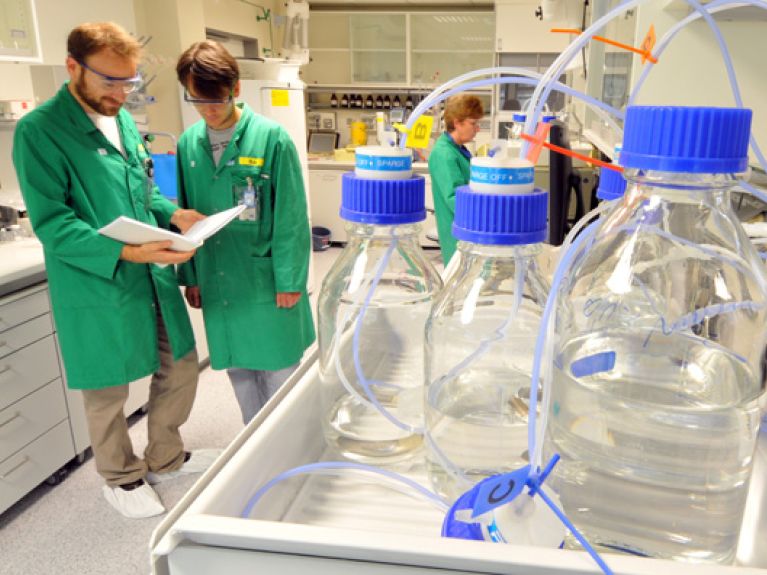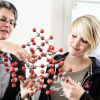Globally networked
German research places great emphasis on internationality and welcomes brilliant minds from abroad. Various strategies are being implemented to promote networking and excellence.

German research won three gold medals: at the end of 2014, Germany was rated best in Europe in Nature Index Global, a comparison of the contributions to research by countries and institutions around the world. In the global ranking, Germany came third, with the first two places going to the USA and China. In a direct comparison of research organisations, the Max Planck Society, which has produced numerous Nobel laureates, ranked first in Europe and third worldwide after Harvard and Stanford universities. In addition, a German company came first in the global ranking of research-oriented enterprises: Volkswagen was again top of the list in 2014, and another four well-known German company names appeared among the Top 20.
Research may not be a sports contest, but there is competition between nations nonetheless when it comes to developing the best innovations and ideas. After all, knowledge is considered the most important “raw material” in the globalised world. Germany is well-placed when it comes to the production of this resource: it has a multifaceted research landscape with three major pillars – more than 400 higher education institutions, a wide range of non-university research institutions with hundreds of institutes and a thriving industrial research sector. Germany’s position as the world champion exporter of high-tech products responsible for 12% of world trade and its secure place among the group of “innovation leaders” in the European Union (EU) is also based on its strong performance in research. This situation should not be taken for granted, however. In recent years, both industry, which shoulders two-thirds of all research expenditure, and the public sector have steadily increased their budgets for knowledge work. Since 2005 the Federal Government has raised its spending in this area by half. Approximately 15.3 billion euros have been allocated for education and research in 2015, and a further 25% increase in this figure is planned by 2017. This growth has led to the creation of 114,000 new jobs in research between 2005 and 2012.
In 2006, Germany also developed a successful innovation policy instrument with its High-Tech Strategy, large parts of which have been taken up by Horizon 2020, the new EU research framework programme. The High-Tech Strategy was updated in 2014: it now primarily aims to support researchers in swiftly transforming good ideas into innovative products and services. Above all, the High-Tech Strategy focuses on research areas that have great future potential: digital industry and society, sustainable business and energy, innovative employment, healthy living, intelligent transport systems and civil security. The instruments and programmes of the High-Tech Strategy are being applied, for example, to strengthen Germany’s practice-oriented universities of applied sciences and to support the internationalisation of excellence clusters and other research networks.
Internationalisation is a key concept. Today, German research is already globally networked. German researchers produce almost half of their academic publications within the framework of international collaborations. The number of foreign researchers who receive funding for a stay in Germany has risen rapidly – to approximately 56,500 today (see page 42). The simplified visa procedures for researchers from non-EU countries that have been introduced in recent years have also played a role in this development. Furthermore, Germany has the highest number of international students – after the USA and the UK.
In addition, many top international researchers are attracted to Germany by its outstanding research infrastructure. It offers opportunities to work with the very best large-scale equipment, such as particle accelerators, observatories for astroparticle physics, unique light sources or neutron and ion sources for materials research. The Helmholtz Association alone runs some 50 large facilities, including the Deutsches Elektronen-Synchrotron DESY, one of the world’s leading accelerator centres for research into the structure of matter. More than 3,000 visiting scientists from over 40 countries do research at DESY every year.
The three major programmes that the Federal Government and the 16 states have agreed for education and research – the Excellence Initiative, the Joint Initiative for Research and Innovation, and the Higher Education Pact – contain many references to international research. Since it began in 2005, the Excellence Initiative has aimed to promote cutting-edge research at German higher education institutions and improve their international competitiveness. This unprecedented programme has already transformed the German higher education and research landscape in a very short time. Internationally oriented excellence clusters and graduate schools have been created at many universities and now offer structured doctoral programmes that are especially attractive for foreign PhD students. All the German universities that have been awarded Excellence Initiative funding contribute to an above-average number of EU projects and are therefore strongly embedded in European research networks. One of the five research policy goals of the Joint Initiative for Research and Innovation is the development and implementation of new strategies for international cooperation. The proportion of foreign researchers in non-university research institutions has increased considerably since the initiative was launched.
Launched in 2009 by the Federal Foreign Office, the Research and Academic Relations Initiative also aims to promote networking around the globe – for example, through the five German houses of research and innovation (DWIHs) in Moscow, New Delhi, New York, Tokyo and São Paulo as well as the German Science Centre Cairo and the work of science officers in German diplomatic missions worldwide.
Other important areas covered by this initiative include the development of the range of scholarships for highly qualified students and graduates as well as cooperation with researchers and higher education institutions in conflict regions and transition countries. During the last six years, four centres of excellence in different fields of research have been established in Chile, Colombia, Russia and Thailand in order to further strengthen the links between international cutting-edge research and German science. Internationalisation will play an even more important role in coming years because policymakers are convinced that excellent research can only be guaranteed in the future with close international cooperation. Furthermore, global cooperation in science and research can play an inestimable role in sustainable and peaceful development. That is why a Strategy for the Internationalisation of Science and Research was drawn up in 2008 under the auspices of the Federal Ministry of Education and Research (BMBF) to strengthen Germany’s role in the global knowledge society.
This strategy is being updated in 2015 to take account of recent developments. They include, for example, the development of the European Research Area (ERA) within the European Union. Germany decisively supports the strengthening of the ERA, within which there should be the “free movement of researchers” and the “free exchange of research findings and technologies”.
In autumn 2014, Federal Research Minister Johanna Wanka presented the International Cooperation Action Plan that forms the basis for the revision of the Strategy for the Internationalisation of Science and Research. It describes how cooperation with developing and newly industrialised countries can be organised and explains how Germany can make an even greater contribution to solving global challenges. “In the future, Germany is to be even better placed to face international competition,” said Federal Minister Wanka at the presentation of the Action Plan. “We want to become a world champion in innovation. To achieve that, we must not only intensify our cooperation with other countries, but also raise it to a new level of quality.”
The competition to win gold medals for the best ideas continues. ▪

